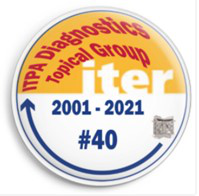Speaker
Description
Among the various compact diagnostics systems, the hybrid CMOS-based and gas electron multiplier (GEM) detectors of multiple sizes, types, and combinations can offer a real “swiss-knife” solution for out-vessel diagnostics of ionizing radiation in experiment of Magnetic and Inertial Nuclear Fusion. They were developed and used, for many years, by the LabNIXT group of ENEA Frascati on many experimental setups (NSTX, FTU, KSTAR, EAST, VEGA, GEKKO, etc.). In particular, the hybrid detectors based on silicon or other semiconductors are realized with a single or multiple chips bump-bonded with a semiconductor layer. Interaction of ionizing radiation in this configuration produces some characteristic tracks inside the detector. The produced charge is collected and recorded as a cluster of pixels. For each cluster, a variety of physical and morphological parameters can be defined. These detectors can be used, with different settings, to discriminate alpha, beta, gammas, hard-X, and neutrons. The hybrid detectors can be coated with one (or more) layers of converter material to observe thermal or fast (with diamond) neutrons. The triple GEM detector is an outstanding candidate for detecting plasma volumes emitting X-ray photons in the 2-30 keV energy range, thanks to its high dynamic range, sensitivity, high rate, energy resolution, and noise-free detection. A hybrid GEM detector that couples the GEM versatility and the hybrid detectors compactness (GEMPix) can be proficiently used for 2-D imaging in all the experimental situations where higher spatial resolution is required, keeping the intrinsic gain. Radiation hard chips for C-MOS and GEM will be required for experiment with a strong radiative background, like ITER.

